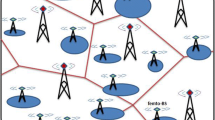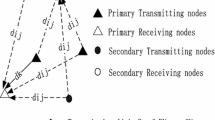Abstract
Motivated by the current demand for improvements in transmission rate and energy efficiency of random wireless cellular networks, we investigate the theoretical model of random cognitive radio network in Rayleigh-lognormal fading environment. In such a network, we derive an analytical expression for the connection probability, transmission rate, and energy efficiency of a secondary network in a single-tier downlink scenario, considering the probabilities of unoccupied channel selection and of successful transmission, where source-destination pairs are randomly located according to Poisson point processes. Moreover, we approach the problem of optimization of transmission rate and energy efficiency using a required connection probability constraint to improve the system performance. Our numerical results indicate that there exists an optimal combination of transmission power and secondary transmitter density where transmission rate and energy efficiency are maximized.










Similar content being viewed by others
Notes
Based on spectrum sensing results, SUs make a channel ranking table depending on the measurement of channel quality \(\left( i.e., \left[ max(P_{d}), min(P_{f}), min(\mathrm{SNR(dB)})\right] \right)\) where SNR is the received signal-to-noise ratio of PT. Then the optimum channel is selected comparison between the measurement of the channel and the standard value \(\left( i.e., \,\left[ P_d \ge 0.9, P_f \le 0.1, \mathrm{SNR} \le -20\, \mathrm{dB}\right] \, \right)\).
References
Abramowitz, M., & Stegun, I. A. (1965). Handbook of mathematical functions: With formulas, graphs, and mathematical tables. New York: Dover Publications.
An, B., et al. (2015). Connectivity analysis of cognitive radio ad-hoc networks with shadow fading. Ksii Transactions on Internet & Information Systems, 9(9), 3335–3356.
Andrews, J. G., Baccelli, F., & Ganti, R. K. (2011). A tractable approach to coverage and rate in cellular networks. IEEE Transactions on communications, 59(11), 3122–3134.
Auer, G., Giannini, V., Desset, C., Godor, I., Skillermark, P., Olsson, M., et al. (2011). How much energy is needed to run a wireless network? IEEE Wireless Communications, 18(5), 40–49.
ElSawy, H., Sultan-Salem, A., Alouini, M. S., & Win, M. Z. (2016). Modeling and analysis of cellular networks using stochastic geometry: A tutorial. IEEE Communications Surveys & Tutorials, 19(1), 167–203.
Goldsmith, A., Jafar, S. A., Maric, I., & Srinivasa, S. (2009). Breaking spectrum gridlock with cognitive radios: An information theoretic perspective. Proceedings of the IEEE, 97(5), 894–914.
Guan, P., & Di Renzo, M. (2015). Stochastic geometry analysis of uplink cellular networks with multi-antenna base stations and interference-aware fractional power control. In 2015 international conference on communications, management and telecommunications (ComManTel) (pp. 13–17). IEEE.
Guo, A., & Haenggi, M. (2013). Spatial stochastic models and metrics for the structure of base stations in cellular networks. IEEE Transactions on Wireless Communications, 12(11), 5800–5812.
Haneggi, M. (2012). Stochastic geometry for wireless networks (p. 2012). Cambridge: Cambridge University Press.
Herath, P., Tellambura, C., & Krzymien, W. A. (2015). Stochastic geometry modeling of cellular uplink power control under composite rayleigh-lognormal fading. In 2015 IEEE 82nd vehicular technology conference (VTC2015-Fall) (pp. 1–5). IEEE.
Li, C., Zhang, J., & Letaief, K. B. (2014). Throughput and energy efficiency analysis of small cell networks with multi-antenna base stations. IEEE Transactions on Wireless Communications, 13(5), 2505–2517.
Li, L., Zhou, X., Xu, H., Li, G. Y., Wang, D., & Soong, A. (2010). Energy-efficient transmission in cognitive radio networks. In 2010 7th IEEE consumer communications and networking conference (pp. 1–5). IEEE.
Li, X., Liu, H., Roy, S., Zhang, J., Zhang, P., & Ghosh, C. (2012). Throughput analysis for a multi-user, multi-channel aloha cognitive radio system. IEEE Transactions on Wireless Communications, 11(11), 3900–3909.
Mahmud, A., & Hamdi, K. A. (2014). A unified framework for the analysis of fractional frequency reuse techniques. IEEE Transactions on Communications, 62(10), 3692–3705.
MATLAB. (2017). The mathworks, inc. [Online]. Retrieved December, 2017 from https://www.mathworks.com/products/matlab.html.
Ni, L., Da, X., Hu, H., & Zhang, M. (2018). Energy efficiency design for secure miso cognitive radio network based on a nonlinear eh model. Mathematical Problems in Engineering 2018.
Pandit, S., & Singh, G. (2017). Spectrum sharing in cognitive radio networks. Berlin: Springer.
Qureshi, F. F., Iqbal, R., & Asghar, M. N. (2017). Energy efficient wireless communication technique based on cognitive radio for internet of things. Journal of Network and Computer Applications, 89, 14–25.
Ren, J., Zhang, Y., Zhang, N., Zhang, D., & Shen, X. (2016). Dynamic channel access to improve energy efficiency in cognitive radio sensor networks. IEEE Transactions on Wireless Communications, 15(5), 3143–3156.
Sabuj, S. R., & Hamamura, M. (2015). Energy efficiency analysis of cognitive radio network using stochastic geometry. In 2015 IEEE conference on standards for communications and networking (CSCN) (pp. 245–251). IEEE.
Sabuj, S. R., & Hamamura, M. (2017). Outage and energy-efficiency analysis of cognitive radio networks: A stochastic approach to transmit antenna selection. Pervasive and Mobile Computing, 42, 444–469.
Sabuj, S. R., & Hamamura, M. (2017). Random cognitive radio network performance in Rayleigh-lognormal environment. In 2017 14th IEEE annual consumer communications & networking conference (CCNC) (pp. 992–997). IEEE.
Sabuj, S. R., & Hamamura, M. (2017). Uplink modeling of cognitive radio network using stochastic geometry. Performance Evaluation, 117, 1–15.
Sabuj, S. R., & Hamamura, M. (2018). Two-slope path-loss design of energy harvesting in random cognitive radio networks. Computer Networks, 142, 128–141.
Soh, Y. S., Quek, T. Q., Kountouris, M., & Shin, H. (2013). Energy efficient heterogeneous cellular networks. IEEE Journal on selected areas in communications, 31(5), 840–850.
Wang, Z., & Zhang, W. (2014). Opportunistic spectrum sharing with limited feedback in poisson cognitive radio networks. IEEE Transactions on Wireless Communications, 13(12), 7098–7109.
Wen, Y., Loyka, S., & Yongacoglu, A. (2012). Asymptotic analysis of interference in cognitive radio networks. IEEE Journal on Selected Areas in Communications, 30(10), 2040–2052.
Win, M. Z., Pinto, P. C., & Shepp, L. A. (2009). A mathematical theory of network interference and its applications. Proceedings of the IEEE, 97(2), 205–230.
Yang, X., & Fapojuwo, A. O. (2014). Performance analysis of poisson cellular networks with lognormal shadowed rayleigh fading. In 2014 IEEE international conference on communications (ICC) (pp. 1042–1047). IEEE.
Yin, X., & Cheng, X. (2016). Propagation channel characterization, parameter estimation, and modeling for wireless communications. Hoboken: Wiley.
Zhang, X., & Haenggi, M. (2014). A stochastic geometry analysis of inter-cell interference coordination and intra-cell diversity. IEEE Transactions on Wireless Communications, 13(12), 6655–6669.
Author information
Authors and Affiliations
Corresponding author
Additional information
Publisher's Note
Springer Nature remains neutral with regard to jurisdictional claims in published maps and institutional affiliations.
Rights and permissions
About this article
Cite this article
Sabuj, S.R., Nur, T.E. & Hamamura, M. An Energy-Efficient Model of Random Cognitive Radio Network: Rayleigh-Lognormal Environment. Wireless Pers Commun 114, 1963–1981 (2020). https://doi.org/10.1007/s11277-020-07457-1
Published:
Issue Date:
DOI: https://doi.org/10.1007/s11277-020-07457-1




